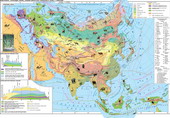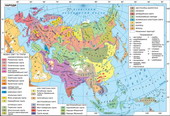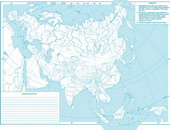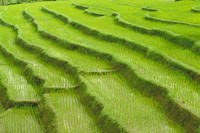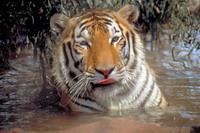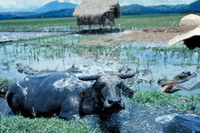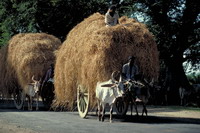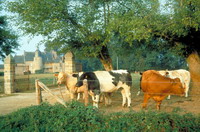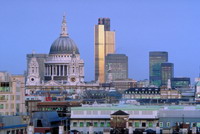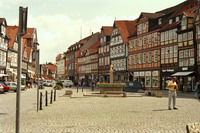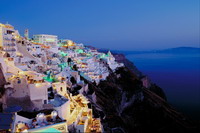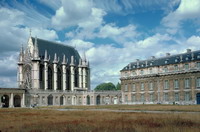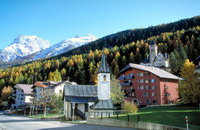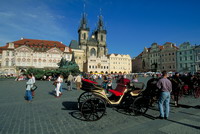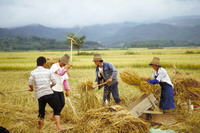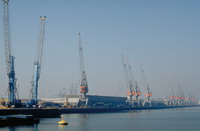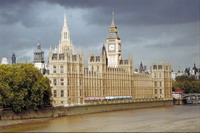in Eurasia of all natural areas of the Northern Hemisphere. In the western part of mainland influence prevailing Atlantic natural areas has caused a change in direction from northwest to southeast. In the eastern part of Eurasia natural areas have meridional reach, due to monsoon circulation of air masses on prytyhookeanskiy territory. Natural areas inside the continent vary in latitudinal direction by changing the temperature and moisture regime in the north and south.
Zone arctic desert from the extremely harsh climatic conditions is the Arctic Islands. There are no solid soil and poor vegetation before unpretentious warmth to the species that survive in permafrost. The animals here frequently polar bears, walruses, seals, caribou .
Thanks mitigating the impact zone of the North Atlantic currents tundra and lisotundry have differences in their western and eastern parts. Near the coast of the mainland European temperate cold climate, and tundra here extends further north than anywhere on the planet. With promotion to the east natural climatic conditions become more severe and tundra and lisotundra occupy larger areas. On the mountain tundra vegetation hanks Siberia penetrates far to the south. Among the plants is dominated by mosses and lichens , which grow on the tundra-hleyovyh soils. Because permafrost is not moisture is inside, so there are many swamps. Major Animals: caribou, fox , some bird species.
Further south lisotundra enters taiga . In a more warm and humid climate here in podzolic soils formed vast tracts of coniferous forests with spruce , pine and larch (the only conifer that winter drops needles). Last prevails in Asian taiga, in a sharply colder climate. Patches of very swampy taiga, many here and peat bogs osokovyh. Is extremely diverse fauna ( brown bear, elk, black cock, wolf, grouse ).
Zone mixed forests and wide- most common in the western part of Eurasia. Here, in conditions of high moisture on turf-podzol soils grow spruce-oak and pine-oak forests in Western Siberia - pine and Birch-aspen forest. Further east, mixed forests disappear and appear again only on the Pacific coast. Wide-shaped forests, mainly oak with and beech , as well as cypress , maple , linden .
For forest zone and steppes There are several zone differences that caused significant climate change with the movement from west to east the mainland. In a warm climate and lack of moisture south of the East formed the fertile black soil and gray forest soils. Flora is represented by patches of forest ( oak, birch, linden, maple ). In the eastern part of the continent if the amplitude of temperature increase and increased dry climate soils are often saline. Flora presented here are poorer and mostly herbs and shrubs. The most typical representatives of fauna and forest-steppe is wolves, foxes, ground squirrel, vole, jerboa and steppe birds . Steppe, and steppe almost entirely under cultivation and natural vegetation preserved only in protected areas and areas unsuitable for plowing.
large areas of central and southwestern parts of the continent occupied zone and semi-desert . Desert zone extends three geographical zones. Common to all deserts are small rainfall, poor soils and vegetation that is well adapted to harsh conditions. Desert Arabian Peninsula during the year highlighted by high temperature, low (up to 100 mm per year) rainfall and essentially a flat surface. Desert subtropics (Iranian Plateau, Central Asia, part of the Gobi Desert) are characterized by significant variations in temperature, richer vegetation, many species of animals. Covered with sand or stones Karakum desert, temperate, Takla Makan, Gobi allocated a large portion of hot summers and severe frosts in winter.
Zone savannas and woodlands are covers most of the Hindustan Peninsula, as well as significant territory Indochina peninsula. In the prevailing climate in monsoonal savannas among high grasses grow single Palm and cassia , which places changing forests. Some trees in the dry season months shed leaves. Wildlife here by elephants , tigers , rhinos , a large number of reptiles .
Zone tverdolystyh evergreen forests and bushes (Mediterranean) is the Mediterranean region. Under warm and wet winters and hot summer is growing evergreen trees and shrubs, the most popular of which is cork and stone oak, bay and arbutus, pine . However, due to intensive economic development of the area the primary vegetation is heavily modified. Common elements of local landscapes are vineyards, olive plantations, wheat fields and other crops that spread in place of the former Mediterranean forests.
Zone variable wet (including monsoon ) Forest extends to the east and south of Eurasia. Vegetation is represented as coniferous and deciduous trees ( cedar, pine, oak, walnut, gingko ), and evergreen ( palm, rubber plant, bamboo and magnolia ), growing mainly the red-yellow soil. Wildlife is also characterized by significant species diversity: monkeys, tigers, leopards , as well as endemic - bamboo bear (panda), gibbon and others.
wealth of flora and fauna characteristic of the zone humid equatorial forests Eurasia. Only palm trees here, there are 300 species, many species of bamboo , which is widely used in work and life. The forests form a high (70 m) trees, some of which have valuable wood. Among impassable haschiv can be found here orangutans, leopards, tapir . Many reptiles and reptile , and various insects .
A significant number of mountain ranges that have different height and distance from oceans, altitude explain Eurasia, characterized by different number of zones. In the northern mountains of mainland only four successive zones. Further south the number of zones increases to five and seven in the Alps on the southern slopes of the Himalayas. A large number of belts is explained by the greatest height of the Himalayas, while on the northern slopes of these mountains through extremely dry climate was formed only two zones.
 English
English
